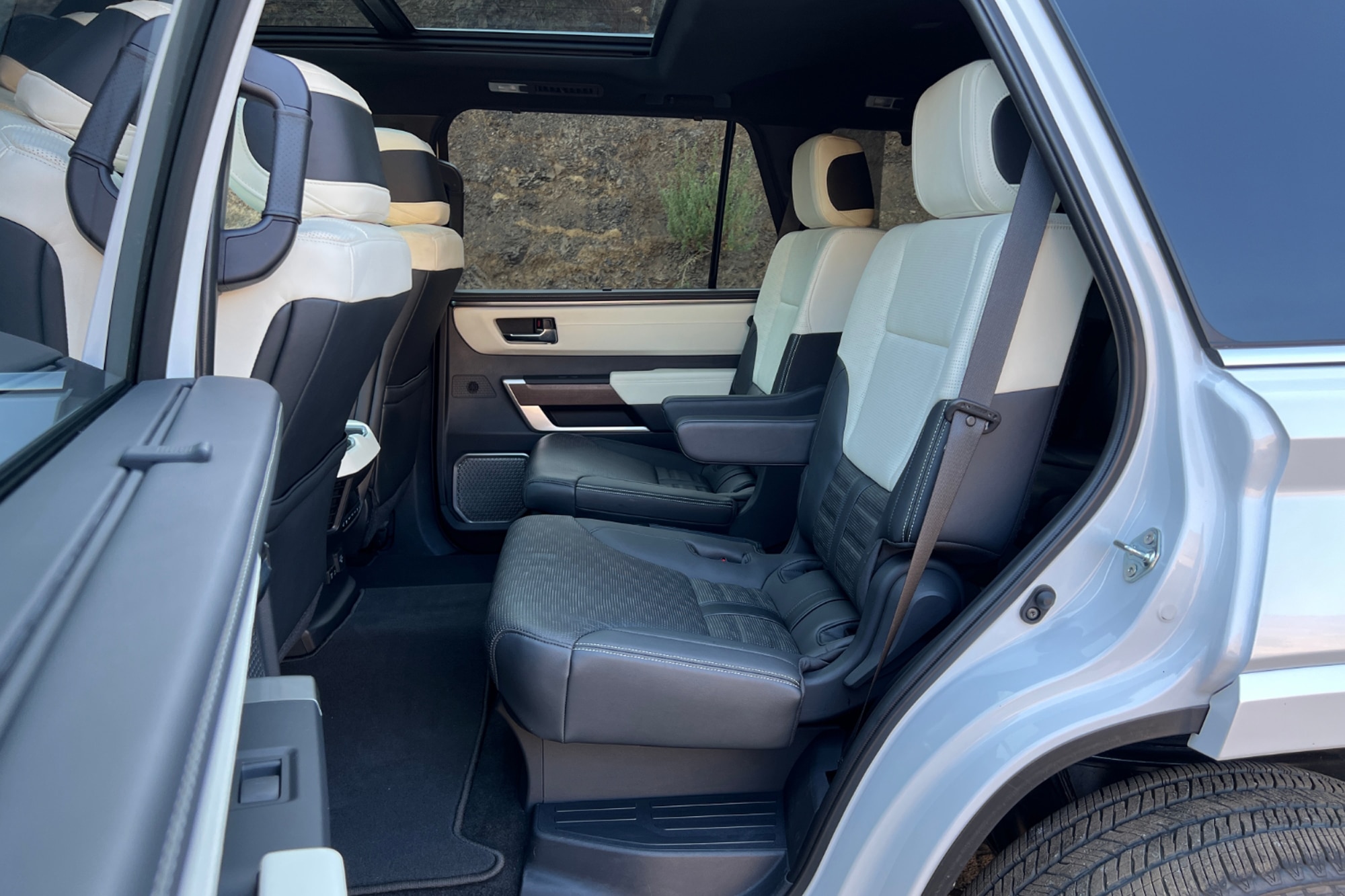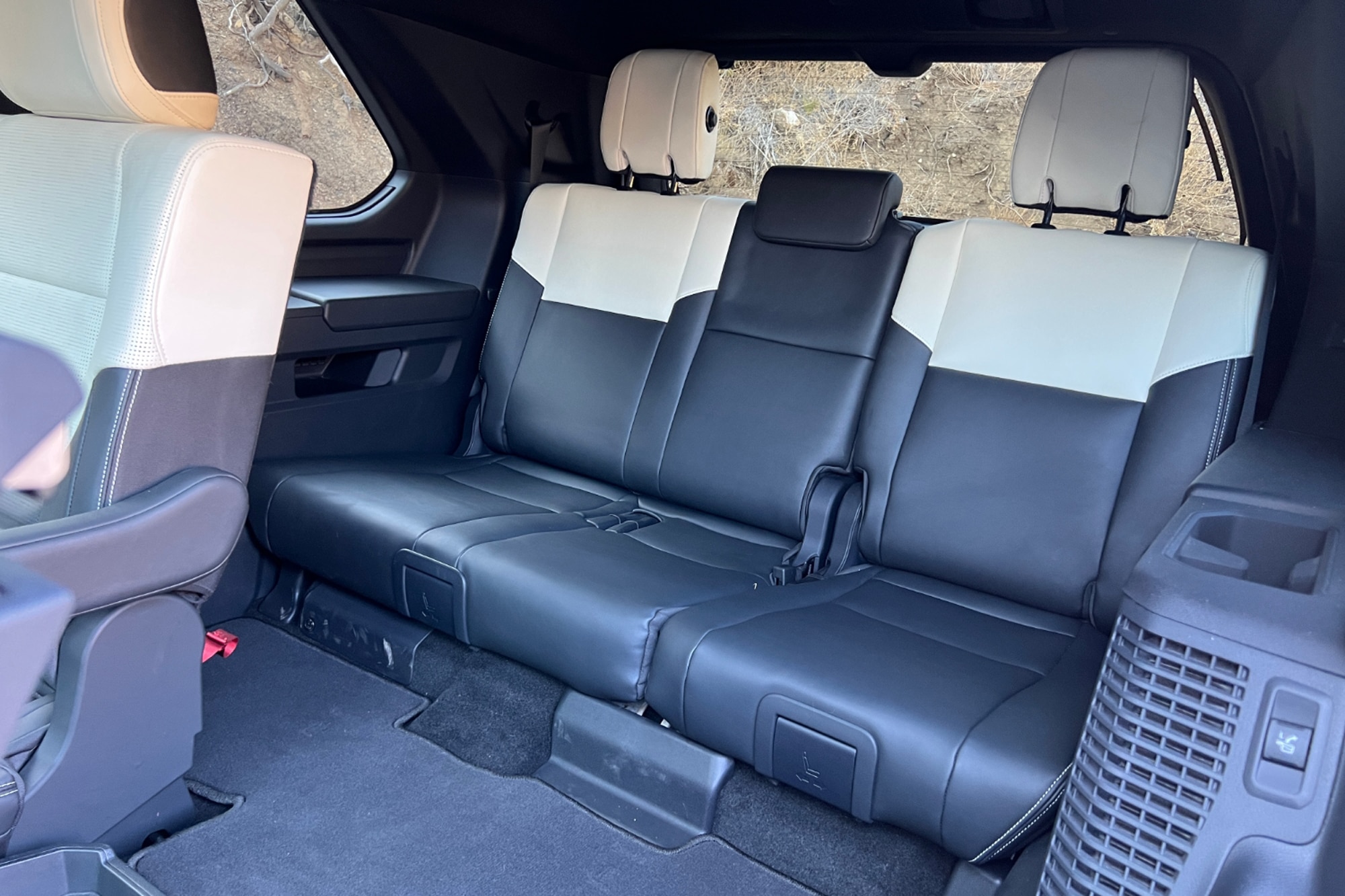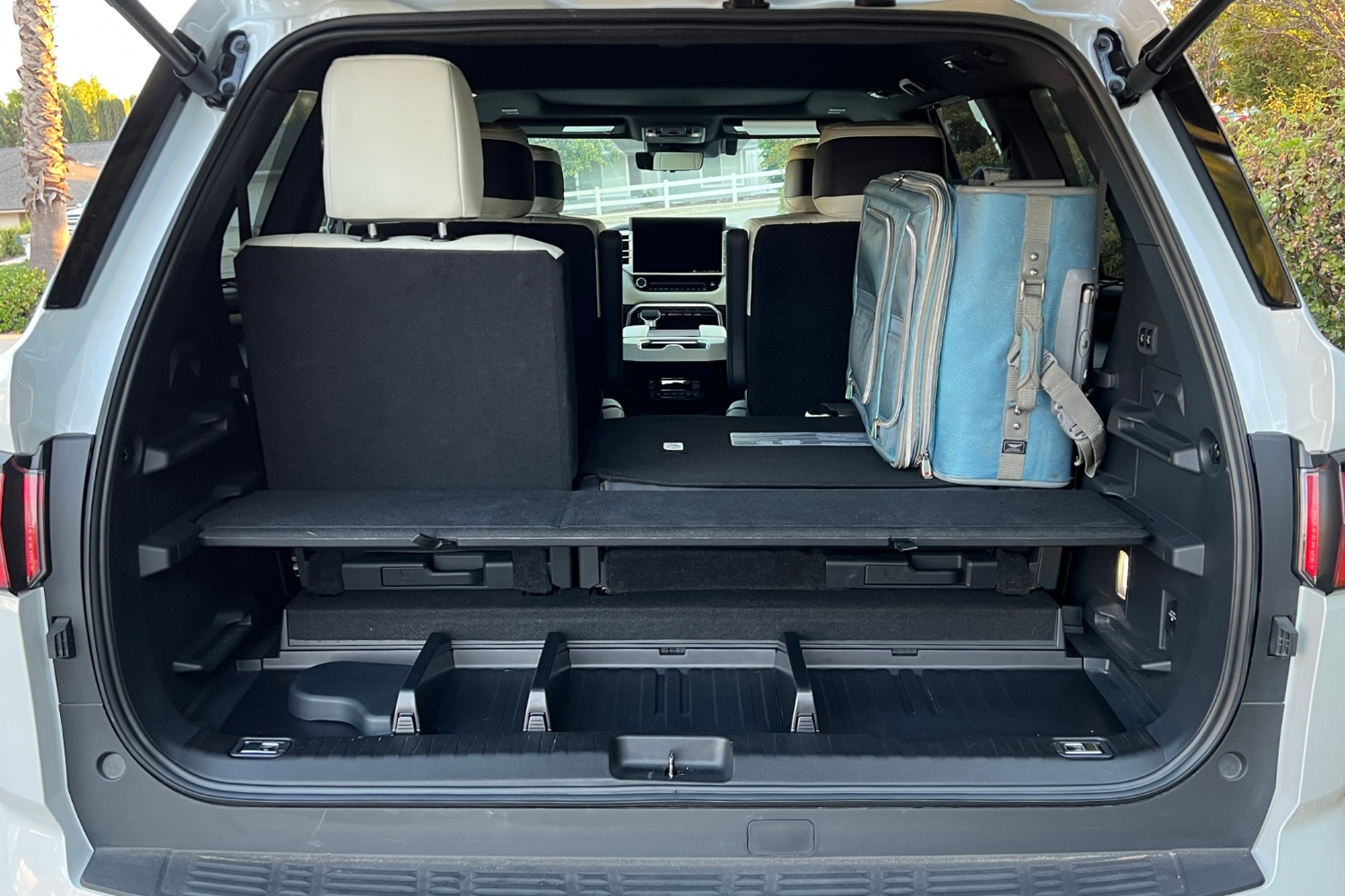2023 Toyota Sequoia Review and Test Drive
Toyota improves the Sequoia in nearly every way, but this SUV is smaller inside.
Capital One
Toyota didn't redesign the second-generation Sequoia for 15 years. That's an eternity in the automotive industry. So, by 2022, its final model year, the Sequoia was uncompetitive in many ways. However, it had proven darn near indestructible, endearing itself to a small but loyal fan base willing to overlook its terrible fuel economy, cheap interior fittings, and aging tech.
Now, a redesigned, third-generation 2023 Toyota Sequoia arrives with distinctive styling, more power, greater fuel economy, and the latest infotainment and driving assistance systems. You can even get a luxury version called the Capstone, which didn't exist before. But unfortunately, the new 2023 Sequoia also shrinks inside, offering a less comfortable third-row seat and compromised cargo space compared to the old model. So does the new Sequoia's less accommodating cabin prove a deal-breaker? That's what I wanted to find out.
But first, let’s set the stage. Toyota moves the redesigned 2023 Sequoia to the all-new Tundra pickup truck platform that debuted last year. It has the same wheelbase as the outgoing Sequoia and is longer than the model it replaces. However, the new Sequoia is also shorter in height, narrower in width, and comes only with a hybrid drivetrain that powers the rear or all four wheels.
 Christian Wardlaw
Christian Wardlaw
Toyota offers the 2023 Sequoia with seven- or eight-passenger seating and rear-wheel drive or four-wheel drive (4WD). In addition, five trim levels are available, each equipped with the same i-Force Max hybrid drivetrain. They include SR5, Limited, Platinum, TRD Pro, and Capstone. At the start of the model year, 2023 Toyota Sequoia prices range from just under $60,000 to nearly $80,000, including the destination charge to ship the SUV from the San Antonio, Texas, factory that builds it to your local dealership.
For this 2023 Toyota Sequoia review I conducted in Southern California, the automaker furnished me with a fully-loaded Capstone model. It was a pre-production version of the SUV, which means it was one of the first examples to roll off the Texas assembly line. The test vehicle had 4WD, extra-cost Wind Chill Pearl paint, and a rear load-leveling air suspension, bringing the Manufacturer's Suggested Retail Price to $81,365, including the $1,595 destination charge.
 Christian Wardlaw
Christian Wardlaw
2023 Toyota Sequoia Review: The Design
As in the past, Toyota bases the new Sequoia on the Tundra full-size pickup truck, and the lineage is evident from the windshield forward. However, the Sequoia's styling isn't quite as distinctive as the Tundra's, and I mean that in the best way. It still has droopy eyelids, but otherwise, it looks normal. Attractive, even.
From the black-painted windshield pillars back, the Sequoia is doing its own thing, and its sharper angles and defined creases give it a tailored look the previous version lacked. At the same time, there is something vaguely retro about the roof, the windows, the fenders, and the rear styling. That could prematurely age the new Sequoia.
Inside, the Sequoia mirrors the Tundra's industrial-looking cabin. Capstone trim adds a creamy white over dark gray color scheme, with premium semi-aniline leather, American walnut wood trim, and polished metallic accents. Think Architectural Digest meets Esquire (those are magazines), and you'll get a sense of the overall swankiness inside. Naturally, some inexpensive parts and pieces bleed through the Capstone's layer of luxury, but that's common in the full-size SUV segment.
In the test vehicle, a 12.3-inch digital instrumentation panel complemented a sizable 14-inch touchscreen infotainment system mounted in landscape orientation on the middle of the dashboard. Smatterings of buttons, switches, and knobs reside in various locations, most having to do with infrequently used secondary functions. Some, like the heated steering wheel button, are located where you'd never think to look. Others, like a tuning knob, are nonexistent.
In addition, it can take some time to learn how to use the digital instrumentation and infotainment system without distraction, and the Capstone's white leather upper seatbacks cause reflections on the display that can make it harder to use. Toyota also equips the Capstone with a large head-up display, but it is nearly impossible to see the data when wearing polarized sunglasses.
Power running boards deploy to help you climb into and out of the Sequoia Capstone. Once they're aboard, four adults will be comfortable in this SUV, which has standard second-row captain's chairs. The Capstone's supple leather, heated and ventilated front and rear seats, and full-size SUV roominess contribute to driver and passenger satisfaction. However, the second-row captain's chairs are fixed in place, so they don't slide back to add more legroom.
 Christian Wardlaw
Christian Wardlaw
In the old Sequoia, adults could easily ride in the third-row seat (and even be happy about it). Unfortunately, that's no longer the case. Since the new 2023 Sequoia has a standard hybrid powertrain with the battery mounted under the third-row seat, this location is now compromised. Both legroom and shoulder room shrink and the bottom cushion offers little in the way of thigh support. There isn't much room for feet, either.
Cargo space also takes a hit due to the battery. The old Sequoia offered 18.9 cu.-ft. of cargo behind the third-row seat, 66.6 cu.-ft. behind the second-row seat, and a maximum of 120.1 cu.-ft. The new 2023 Sequoia's cargo space measures 11.5, 49, and 86.9 cu.-ft., respectively. Not only does this represent a substantial reduction in utility, it also makes the Sequoia barely more cargo-capable than a Toyota Highlander.
Not only is the cargo area smaller, but it's also less convenient to use. Since the third-row seats fold in half on top of the battery, the only way for Toyota to offer a level load floor is by equipping the Sequoia with an adjustable cargo shelf. Place it in its middle position, which will line up with a folded third-row seat, and you can slide four full-size suitcases into the Sequoia on their sides. That will leave space for more luggage on the upper deck (a couple of roll-aboards). Below the deck, you'll have room for smaller items such as backpacks.
Ultimately, space remains useful. You just need to rethink how you might usually pack a vehicle for a trip. But you'd better go light with those full-size suitcases. Otherwise, you'll get a workout loading and unloading them from the high upper deck.
Lastly, you should know that Toyota has eliminated the old Sequoia's power liftgate window, replacing it with a flip-up piece of glass. However, this new window should allow quick access to whatever you might have stored on the adjustable shelf behind it.
 Christian Wardlaw
Christian Wardlaw
2023 Toyota Sequoia Review: The Technology
When it comes to technology, there is no comparison between the old Sequoia and the new one. Instead, this SUV has taken a giant leap forward with its more sophisticated infotainment system, safety features, and more.
If you get a base Sequoia SR5 without the optional Premium package, you'll get an 8-inch touchscreen infotainment display that Toyota has somehow made to look like a natural fit on the dashboard. Every other version of this SUV comes with a billboard-sized 14-inch touchscreen that does not offer a split-screen view of content. So, for example, you can't see the navigation map and the music you're listening to simultaneously. Instead, you must switch screens to see where you are or what artist is streaming through the stereo speakers.
Both infotainment systems use new Toyota Audio Multimedia technology. Highlights include simultaneous Bluetooth pairing for two devices, wireless Apple CarPlay, wireless Android Auto, and SiriusXM satellite radio (with a free 90-day subscription). Additionally, five different connected services plans come with both versions of the infotainment system and include complimentary trial subscriptions that vary in length depending on the plan.
Examples include Safety Connect, which includes features like emergency assistance and automatic collision notification. Wi-Fi Connect provides access to an in-vehicle Wi-Fi hotspot. Remote Connect allows you to interact remotely with the Sequoia via smartphone or smartwatch or use digital assistants such as Amazon Alexa and Google Assistant. You can also remotely start the engine, locate the vehicle, and perform other functions from a distance. Finally, Drive Connect adds cloud-based navigation and an Intelligent Assistant that responds to naturally spoken voice commands.
All of these features were active in the test vehicle, and, for the most part, the ones we sampled worked as expected. The "Hey Toyota" Intelligent Assistant is great, but the Sequoia's available JBL premium audio system is merely good.
Aside from reflections, glare, and the lack of a split-screen view, there is another problem with the infotainment system. You can easily forget where you initially found a feature or setting, and when you decide you want to adjust it, you spend lots of time hunting for it. Plus, I can't figure out why Toyota added a volume knob to the left of the climate controls and didn't match it with a tuning knob to the right. Instead, there is an exposed USB port in that location. The result is jarring asymmetry and a missing, often-used control knob.
Additional tech features in the Capstone test vehicle included a head-up display and a digital rearview mirror. In addition, all Sequoias have a surround-view camera, parking sensors, and a rear automatic braking system, so you should be able to maneuver this large SUV confidently.
In addition to those parking aids, the standard list of driving assistance and collision avoidance technologies is long. The automaker groups several features under the Toyota Safety Sense 2.5 (TSS 2.5) umbrella, including automatic high-beam headlights, adaptive cruise control, forward-collision warning with pedestrian detection, automatic emergency braking, lane-departure warning, lane-keeping assist, and lane-centering assist. The Sequoia also comes with blind-spot monitoring and rear cross-traffic alert.
During my evaluation, TSS 2.5 performed well. The beeping from the lane-departure warning system can aggravate a driver, but otherwise, the features I could safely assess did a great job. However, I encountered a situation while reversing out of a parking space at my local grocery store. Pedestrians walking behind the SUV on the other side of the aisle appeared clear of the Sequoia, but they either cut across behind me while I was backing up, or I misjudged their distance based on the camera view. In any case, the automatic rear braking system detected these pedestrians and stopped the SUV.
 Christian Wardlaw
Christian Wardlaw
2023 Toyota Sequoia Review: The Drive
Americans may find it hard to give up their V8 engines, but one drive in a new 2023 Toyota Sequoia could convince them a twin-turbo V6 based hybrid might be the way to go.
Open the SUV’s hood, and you'll find the automaker's i-Force Max power plant, a twin-turbocharged 3.5L V6 fortified with a 36kW electric motor/generator sandwiched between the internal combustion engine and the 10-speed automatic transmission. Output measures 437hp and 583 lb.-ft. of torque, which is good for a maximum tow rating of 9,520 lbs. and a maximum payload rating of 1,730 lbs. (both figures are for the SR5 trim and two-wheel drive).
Compare those specs to the old Sequoia, which had a 5.7L V8 making 381hp and 401 lb.-ft. and could tow no more than 7,400 lbs. or carry more than 1,405 lbs. of payload. Plus, the old Sequoia earned official EPA fuel economy ratings of 14 to 15 mpg in combined driving with its six-speed automatic transmission. The 2023 model uses a ten-speed automatic and should get 20 to 22 mpg.
I know. The V8 sounded great. Admittedly, the i-Force Max isn't as aurally pleasing, but Toyota does pipe in a simulated engine and exhaust note through the stereo speakers, and it sounds decent. Maybe you can find an online source of V8 revving sounds and stream it into the SUV.
Here's another wrinkle with the new 2023 Sequoia. It has less ground clearance and shallower approach and departure angles, even if you choose the TRD Pro trim level. Also, check out the lower air dam on the Capstone and tell me you'll take it off-roading. That thing might not even clear parking blocks without incurring some damage.
 Christian Wardlaw
Christian Wardlaw
On the testing loop, the i-Force Max hybrid powertrain offered plenty of acceleration for merging onto fast-flowing freeways and coastal highways. However, with its peak torque arriving at just 2,400 rpm, it can leap forward more aggressively than you might expect when driving in the city, suburbs, or bumper-to-bumper traffic, so use a light foot in these situations.
In addition, prepare to work this SUV's steering wheel in parking lots because it takes more than a flick left or right to park this rig or negotiate tight parking garages. Also, the regenerative braking system that captures energy and feeds it to the i-Force Max's battery can produce a poor pedal feel that makes it hard to smoothly modulate the brakes, resulting in inconsistent slowing and stopping behavior.
The Sequoia Capstone offers Eco, Comfort, Normal, Sport, Sport+, and Custom driving modes. These adjust the powertrain characteristics and modify the SUV's optional adaptive suspension. Add this model's heavy 22-inch wheels and their 265/50 all-season tires, and you discover that it's almost impossible to find a setting that offers a smooth ride without excessive body motions.
In Eco or Comfort mode, the powertrain response is lazy, and the ride is soft and wallowy. Normal gives you better acceleration, but impact harshness filters into the cabin. Sport and Sport+ produce rousing performance while better controlling unwanted body motions, but the firm suspension setting pummels the interior with road shock unless you're traveling on glass-smooth pavement.
It's also worth noting that the Sequoia does not offer an automatic 4WD mode. Instead, you can choose two-wheel drive (2WD), 4-Hi, or 4-Lo. That could be an issue for people who live where it snows and who might prefer an automatic transfer case like those offered by Toyota's rivals.
You're probably wondering if the new Sequoia matched the official EPA fuel economy estimates during testing. Unfortunately, it did not. Using Normal mode, except when driving in the mountains in Sport mode, the Sequoia averaged 17.8 mpg on my evaluation loop. Most people could likely improve on that, but perhaps not enough to get the 20 mpg they expect.
 Christian Wardlaw
Christian Wardlaw
Is the 2023 Toyota Sequoia a Good SUV?
The answer to this question depends on why you're buying it. If you want a full-size SUV to ensure comfort in all three rows of seats combined with maximum cargo volume, the new Sequoia likely is not the SUV for you. On the other hand, if you want a full-size SUV for occasional towing and the rest of the time you're planning to haul a family of four, and you want decent gas mileage for that task, then yes, the Sequoia is worthy of consideration. However, you've gotta really want a Toyota or really want a hybrid to pick the new Sequoia over some of its rivals.
Written by humans.
Edited by humans.
 Christian Wardlaw
Christian WardlawMy first word was “car.” That’s what I’m told, anyway. For as long as I can remember, I’ve been obsessed with them. The design. The engineering. The performance. And the purpose. I’m a car enthusiast who loves to drive, but I’m also most interested in the cars, trucks, and SUVs that people actually buy. Anybody can tell you that a sports car is fast. What you need to know is whether or not you should buy that new SUV, and why. My life purpose is to help you make that decision.
Related articles
View more related articles